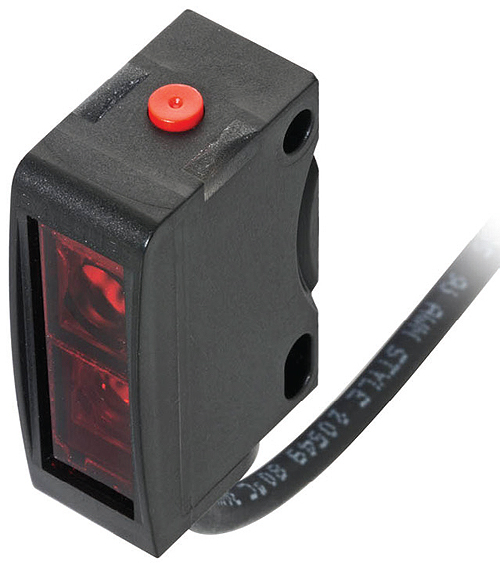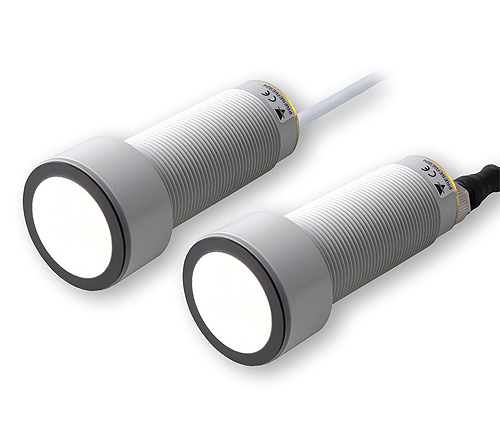by Michael Jermann, Assistant Editor
Even though Moore’s Law was developed for computing hardware, it also appears to apply to other devices and equipment. Technology helps designers create smaller, yet more powerful machines, assemblies, controls and other systems. Size reduction contributes other benefits to equipment and machinery: less floor space is needed, mobile equipment is lighter and more energy efficient, and material costs are often less. Sensors are no exception; their reduction in size has added benefits beyond reduced costs and high efficiency. Smaller sensors mean a greater number of application opportunities and even a chance to improve upon existing ones.
Balluff’s BOS 6K series’ 31.5 x 19.5 x 10.8 mm dimensions are suitable for tight spaces in compact machines. Its 70 variants feature red light and laser versions (class 1) for demanding jobs. The range features diffuse sensors, through-beam sensors, reflection light sensors with and without background suppression, and analog distance sensors, each with the flexibility to be configured for light/dark switching.

All of the sensors have a tough and durable plastic housing with abrasion-resistant laser inscription. A special design element protects the optics from the side. Thanks to its IP 67 and IP 69K degrees of protection, a lens surface of PMMA and Ecolab approval, the BOS 6K is also a prime choice for use in the food industry.
All of the variants feature teach buttons with tactile feedback. If the installed sensor is difficult to access, remote control lets operators program them from a distance. The sensor functions can also be configured during ongoing operation. Two LEDs, easily visible from any direction, properly provide information at a glance. They indicate the operating state, the function reserves and the switching state. Durable metal plugs ensure there are no outages under high mechanical loads.
Switching from an earlier model to the new BOS 6K generation is easy. The size, installation and operating concept are identical.
The retro-reflective light sensor with auto-collimation easily detects transparent objects made of glass, such as bottles, ampules or test tubes, or transparent plastic films thanks to its low hysteresis.
Baumer’s MIR 10 bearingless encoders are suited for position and speed feedback in limited installation space. Operating on non-contact magnetic sensing with up to 4096 ppr, the long life encoders won’t wear.

The fully encapsulated magnetic sensor, with IP 66 and IP 67 as standard protection, is resistant to environments with dust, chippings or oil, but also with constant and cyclic humidity at extended temperatures ranging from -40° to 85° C. Sized 10 x 15 x 45.5 mm, the sensor is compact. The matching pole wheels are 14 to 15 mm in depth and fit shafts from 6 to 43.5 mm.
The shock and vibration proof sensing head withstands 500 resp. 30 g. The metal housing ensures a high electromagnetic compatibility, which is aided by shielded Polyurethane cable twisted in pairs for added protection against electromagnetic interference.
Bearingless encoder MIR 10 is available with 5 VDC supply and TTL / RS422-compatible line drivers and as 10….30 VDC version with pushpull. Both variants output two channels with 90° shift and inverted signals. As an option, both zero pulse and inverted channels provide magnetic encoding by reference magnet. The encoder comes with a distance gauge to ease mounting and to make sure the exact gap between pole wheel and sensing head is kept.
Carlo Gavazzi’s UA30CAD60 Series ultrasonic sensors, with digital and analog output configurations, feature longer sensing ranges. With its simple teach procedure and shorter M30 PBT housing, the sensor suits difficult distance and level applications.

This new family of ultrasonic sensors has two different output configurations. The first has two digital NPN or PNP outputs. The second has an analog output in either 4-20 mA or 0-10 VDC, as well as one digital NPN or PNP output. The two digital outputs can be set as standard switching outputs with two set points or as a window function. The analog output can be set with a positive or negative slope for both filling and emptying applications.
The sensors offer sensing distances of 250 to 6000 mm (6 meters) and are available as either cabled or M12 quick-disconnect versions. The UA30CAD60 Series sensors are for use in a variety of applications, including: material handling, food and beverage, HVAC, packaging, plastics, agriculture and automotive. The sensors also feature IP67 ratings and NEMA 1, 2, 4, 4X, 5, 6, 6P, 12.
The XM/XT Series from Gems Sensors and Controls is a family of single float transmitters for high-accuracy continuous fluid level monitoring within smaller, more compact tank environments.

Historically, off-highway vehicle, HVAC, locomotive, commercial printing and medical OEMs have had limited capability for accurate fluid level monitoring of tank depths less than 50.8 cm (20 in.).
Gems XM/XT-300 Series fluid level transmitters are constructed from all-wetted polysulfone plastic parts. This ensures compatibility with a variety of chemicals. Its counterpart, the Gems XM/XT 700 Series, combines the extended durability of stainless steel, or brass, within a lightweight package. Both models serve as effective drop-in replacements using existing tank fittings. They feature 3.5 mm (0.14 in.) resolution; an indicating length to 35.5 cm (14 in.); and a stem length to 50.8 cm (20 in.). Compact and versatile, XM/XT Series units are also available with a broad choice of mountings and float materials to suit individual requirements.
Balluff
www.balluff.com
Baumer
www.baumer.com
Carlo Gavazzi
www.carlogavazzi.com
Gems Sensors and Controls
www.gemssensors.com
